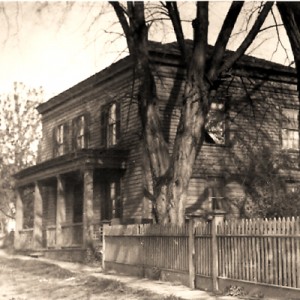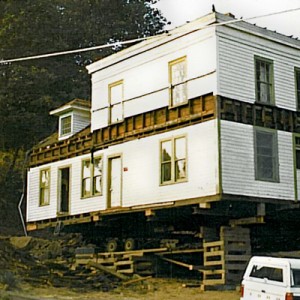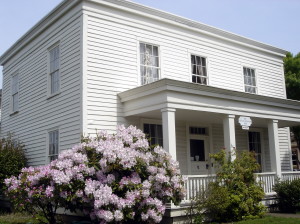
is supported by donors like you
When it comes to Oregon history, it doesn’t get much more significant than the Ermatinger House. In 1845, Francis Ermatinger built for himself a federal style residence in what is now downtown Oregon City.
Ermatinger was a powerful and influential figure in early Oregon history, serving as a chief trader for the Hudson’s Bay Company, and holding public office in the Oregon Provisional Government in 1845. Although located in Oregon City, the Ermatinger House holds a special place in Portlander’s hearts. It is rumored that in the left parlor the famous coin toss occurred between Francis Pettygrove and Asa Lovejoy during a dinner party held in 1845. The two were arguing about whether the town to be built on their land claim (then called The Clearing) should be incorporated as “Boston” or “Portland.” Pettygrove won two out of three tosses, resulting in the city of Portland, Oregon.
The house was sold in 1849 by Ermatinger’s close frien
 d, Dr. John McLoughlin. The house remained in its original location near the Willamette River until 1910 when it was moved up the hill in Oregon City onto a highly sloped lot, spending the next 67 years in anonymity as a rental. In 1977, the house was acquired by noted Oregon preservationist Ruth McBride Powers and moved in 1986 to city-owned property where it transitioned to a house museum.
d, Dr. John McLoughlin. The house remained in its original location near the Willamette River until 1910 when it was moved up the hill in Oregon City onto a highly sloped lot, spending the next 67 years in anonymity as a rental. In 1977, the house was acquired by noted Oregon preservationist Ruth McBride Powers and moved in 1986 to city-owned property where it transitioned to a house museum.Over the years, the City of Oregon City supported the maintenance of the house and the museum, but could not keep up with the mounting needs of the structure. In 2009, the city undertook a window repair project for the historic and replacement wood windows. What they soon began to realize was the house was twisting inward and the walls, if not stabilized, could potentially fall in on themselves. The house was quickly boarded and the house museum was shuttered. By 2010, the future of one of the oldest houses in Oregon was at risk and the city was slowly waking up to the realization that their meager maintenance budget was woefully too small for this task. Ermatinger House supporters and volunteers, Historic Review Board members, City Commission and staff spent much of that year spinning in circles trying to get their a handle on the problem.
 In the spring of 2011, the city decided to submit an application to the Endangered Places program figuring that the extra exposure and help from the Restore Oregon (then HPLO) would be beneficial to the city. Little did we know that the Endangered Building listing and the ensuing publicity and support from Restore Oregon staff would be the catalyst that helped launch the current rehabilitation program. As soon as the list was released, the city was inundated with a swarm of support from citizens throughout the city, region and state who wanted to be involved with saving the house.
In the spring of 2011, the city decided to submit an application to the Endangered Places program figuring that the extra exposure and help from the Restore Oregon (then HPLO) would be beneficial to the city. Little did we know that the Endangered Building listing and the ensuing publicity and support from Restore Oregon staff would be the catalyst that helped launch the current rehabilitation program. As soon as the list was released, the city was inundated with a swarm of support from citizens throughout the city, region and state who wanted to be involved with saving the house.
Support Oregon’s Most Endangered Places
Oregon City was able to capitalize on this publicity and raised enough money to move forward with rehabilitation of the the house in the spring of 2014. A team led by Maya Foty of Architectural Resources Group and TS Gray Construction recently completed the approximately $800,000 rehabilitation project with a support from Clackamas Community Development Block Grants, and the State Historic Preservation Office. Today, the Ermatinger House sits on a new foundation (both physically and metaphorically) and is ready to open its doors once again.
Nationally and locally, house museums are facing tough times. Visitors and volunteers are aging and their small budgets often cannot maintain these older buildings. As a publically owned building, Oregon City is in a bit of a different position, it is too small to reuse as an events center and too precious to the community to rent as an Airbnb rental, something other organizations are moving to as potential solutions. What we do have are a small, but very passionate, group that wants to keep it operating as a house museum. They are working with the City on a new agreement and expectations for support and programming.
Restore Oregon has created a savvy program that shines a statewide light on the problems facing endangered buildings. This program is much more than a simple list. Often times these buildings are endangered because the local communities don’t know how to ask for help or even know what resources are available to them. If it weren’t for this program, I truly believe that Oregon City would still be looking at a shuttered building with no plans for its future.
Oregon’s Most Endangered Places depend upon the generosity of donors like you.

